Gr 10 AP Science Review Flashcards
1/101
There's no tags or description
Looks like no tags are added yet.
Name | Mastery | Learn | Test | Matching | Spaced |
|---|
No study sessions yet.
102 Terms
Methane
CH4, a colorless, odorless gas that is the main component of natural gas and a significant greenhouse gas.
Ozone
O3, a pale blue gas that absorbs most of the sun's harmful ultraviolet radiation.
Hydrogen Peroxide
H2O2, is a colorless liquid used as a disinfectant and bleaching agent.
Ammonia
NH3, is a colorless gas with a strong odor, commonly used as a fertilizer and in cleaning products.
What prefixes do you use when writing chemical compounds?
You use prefixes such as mono-, di-, tri-, tetra-, penta-, and hexa- to indicate the number of atoms of each element in a chemical compound.
Diatomic Elements
Elements that exist as molecules composed of two atoms, such as H2, O2, and N2. BrONClIF are examples of diatomic elements.
Lewis Dot Diagram
A diagram that shows the bonding between atoms of a molecule and the lone pairs of electrons. It visually represents the valence electrons and how they are shared or transferred in covalent or ionic bonds.
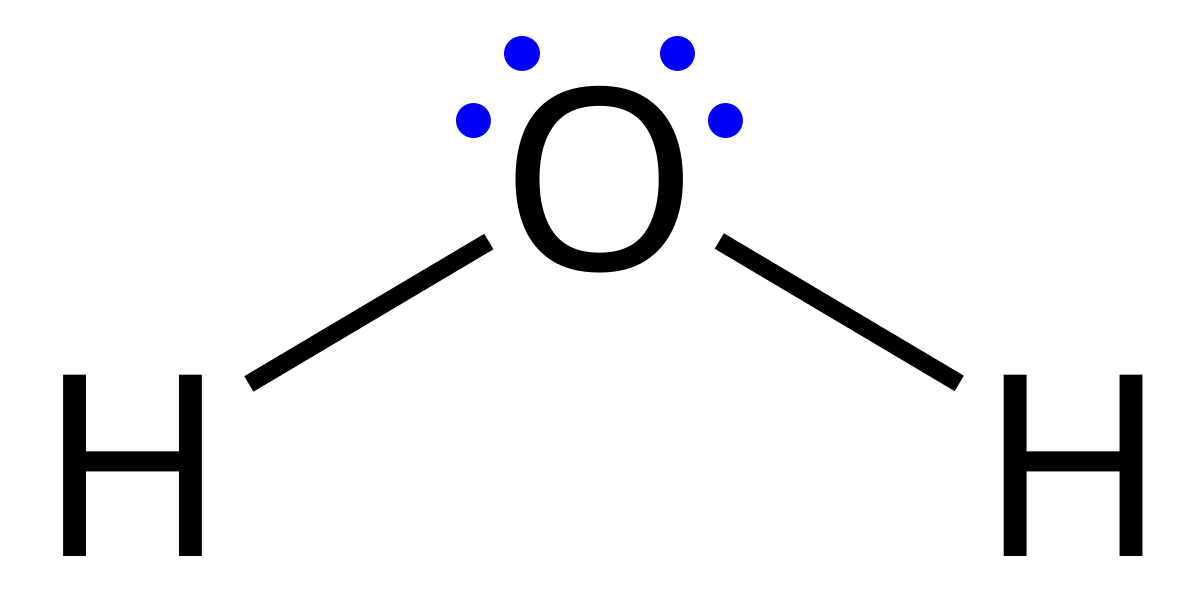
Electronic Configurations
The arrangement of electrons in an atom's orbitals, which determines its chemical properties and reactivity. It follows the Aufbau principle, Hund's rule, and the Pauli exclusion principle.
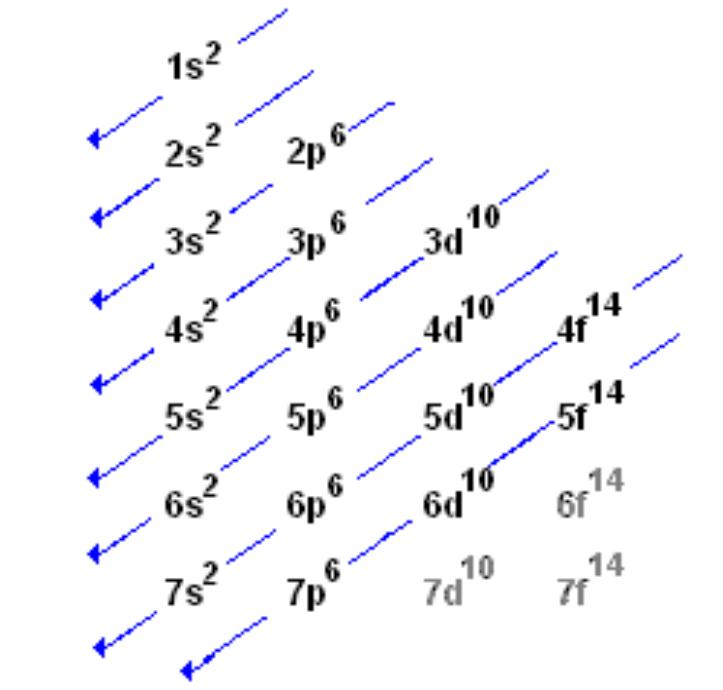
S Orbital
A type of atomic orbital that can hold a maximum of two electrons and is spherical in shape, found in each energy level.
P Orbital
A type of atomic orbital that can hold a maximum of six electrons and has a dumbbell shape, existing in energy levels starting from the second level.
D Orbital
A type of atomic orbital that can hold a maximum of ten electrons and has a complex shape, existing in energy levels starting from the third level.
F Orbital
A type of atomic orbital that can hold a maximum of fourteen electrons and has a complex shape, existing in energy levels starting from the fourth level.
Types of Chemical Reactions
The classifications of chemical reactions based on the changes in chemical bonds, including synthesis, decomposition, single replacement, double replacement, and combustion.
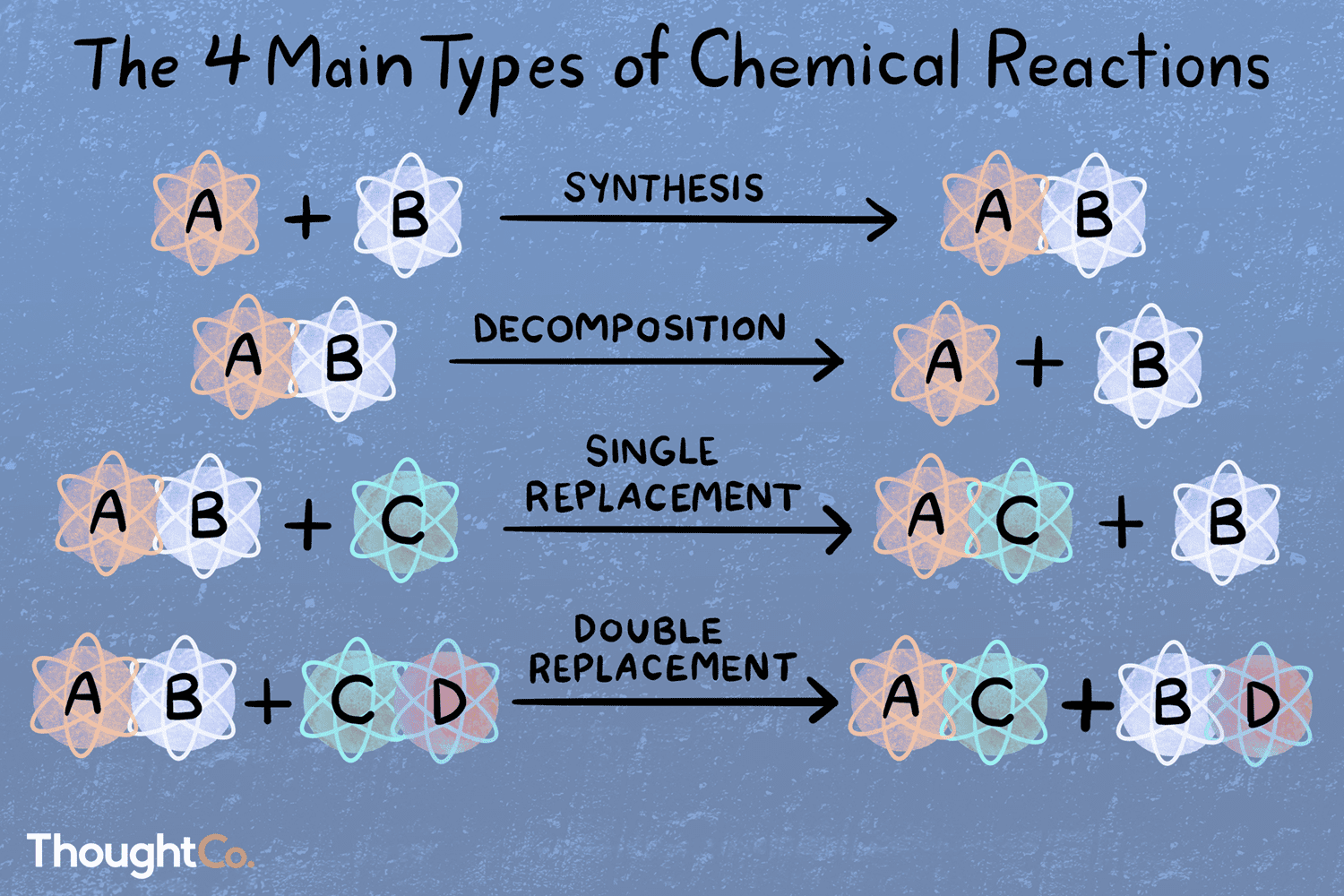
pH Scale
A scale used to measure the acidity or alkalinity of a solution, ranging from 0 to 14, with 7 being neutral. Lower values indicate acidity, while higher values indicate alkalinity.
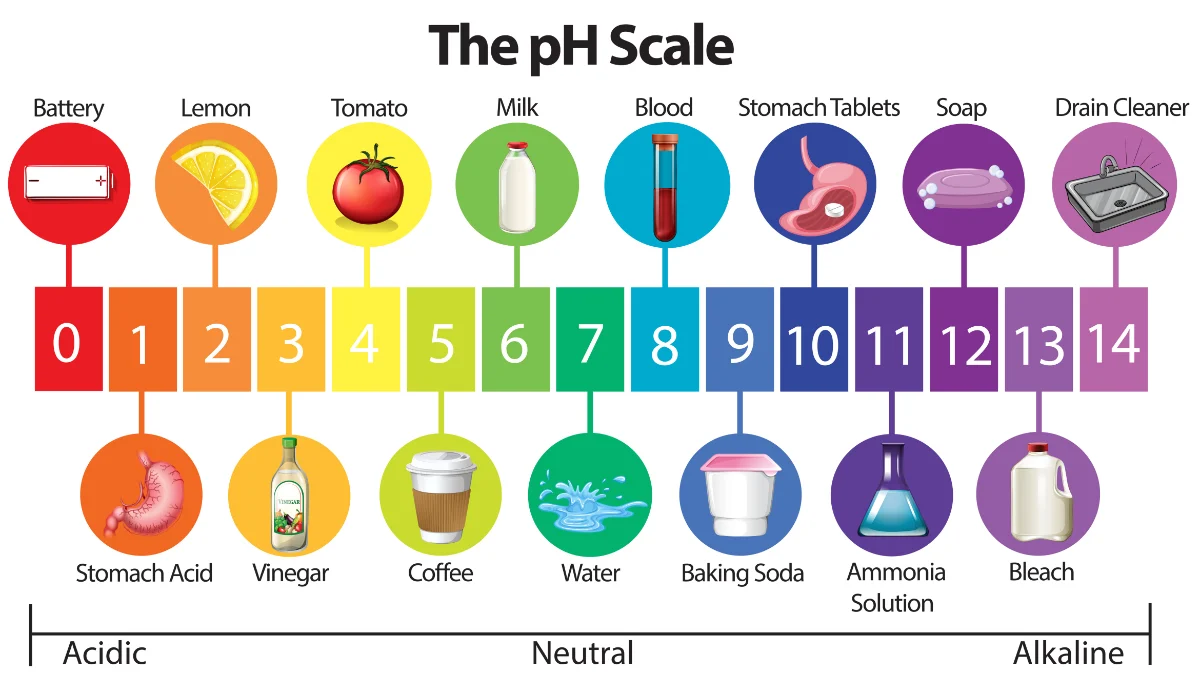
Acids
They have a sour taste, caused by the hydrogen ions (H+). Most are caustic, burning, and corrosive. They can donate protons (H+) and typically have a pH less than 7.
Bases (Alkaline Solutions)
They have a bitter taste, caused by the hydrogen oxide ions interacting with your taste receptors (OH-). Most have a slippery feel to them when touching skin. They can receive protons (H+) and usually have a pH more than 7.
When acids and bases mix?
When a chemical reaction happens between acids and a bases. Acids usually gives protons (H+) to a base, this donation allows the acid and base to neutralize each other. This also results in the production of salt and water (H2O).
Definition of Reflection?
The bouncing of light or other waves off a surface.
Definition of Refraction?
The bending of light as it passes from one medium to another (e.g., air to water).
Definition of Diffuse?
Light scattered in many directions, typically after hitting a rough surface.
Definition of Specular?
Light reflected off a smooth surface in a single direction (like a mirror).
Definition of Total Internal Reflection?
Occurs when light hits a boundary between two media at a steep angle and is completely reflected. The conditions for this to happen:
The light must be in the denser medium (e.g., water).
The angle of incidence must be greater than the critical angle.
Index of Refraction?
A measure of how much light slows down in a material. The higher the index, the slower the light travels.
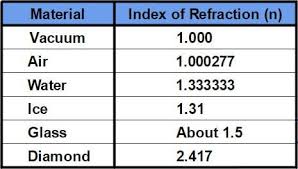
Hyperopia
Farsightedness, where distant objects are seen clearly, but nearby objects appear blurry.
Myopia
Nearsightedness, where nearby objects are seen clearly, but distant objects appear blurry.
Plane Mirror
A flat, smooth mirror that creates a virtual image that is the same size as the object, but reversed.
Concave Mirror
A mirror with an inward-curved surface. It can magnify images or focus light to a point (used in telescopes and makeup mirrors).
Convex Mirror
A mirror with an outward-curved surface. It creates smaller, wider images and is used for safety (like in car side mirrors).
Converging Lense
A lens that bends light rays inward, causing them to meet at a single point (focus). It is thicker in the center than at the edges and is used in magnifying glasses and cameras.
Diverging Lense
A lens that spreads light rays outward. It is thinner in the center than at the edges and is used to correct nearsightedness (myopia).
Laws of Reflection
The laws of reflection are:
The Angle of Incidence Equals the Angle of Reflection: The angle at which the light hits the surface (incident angle) is equal to the angle at which it bounces off (reflected angle), both measured from the normal (a line perpendicular to the surface).
The Incident Ray, Reflected Ray, and Normal All Lie in the Same Plane: The incoming light, the reflected light, and the normal all exist in the same flat plane.
Speed of Light Calculation
The formula for the speed of light in a medium is:
n = c / v
Where:
n is the index of refraction of the medium,
c is the speed of light in a vacuum (approximately 10^83×108 m/s),
v is the speed of light in the medium.
To calculate the speed of light in a medium, rearrange the formula:
v = c / n
So, if you know the index of refraction n, you can find the speed of light in that medium by dividing c by n.
Plant Cell
They are the basic building blocks of plants. They have a cell wall for added structure, a large vacuole for storing water and nutrients, and chloroplasts that contain chlorophyll for photosynthesis (making food from sunlight). These features are not found in animal cells.
Animal Cell
These cells are the basic units of animals. They do NOT have a cell wall or chloroplasts, and they typically have smaller vacuoles. Instead of a cell wall, these cells have a flexible cell membrane. These cells also have structures like centrioles that are involved in cell division, which are not present in plant cells.
Prokaryotic Cells
These cells are simple, single-celled organisms (like bacteria) that lack a nucleus. Their genetic material is not enclosed in a membrane but is found in a region called the nucleoid. They also have fewer organelles compared to eukaryotic cells.
Eukaryotic Cells
These cells are more complex and can be single-celled (like protists) or part of multicellular organisms (like plants, animals, and fungi). They have a nucleus that holds their genetic material, and they contain various membrane-bound organelles (like mitochondria, chloroplasts in plants, and the endoplasmic reticulum).
Cell Membrane
Cells have this external and it controls what goes in and out.
Cell Wall
External, part of most prokaryotic cells and some eukaryotic cells. Important for cells shape and structure, offers protection.
Centrioles
Found in eukaryotic cells, but not all. Comes from the centrosome ( 2 per centrosome ), also apart of cell division ( Spindle fibers involved.
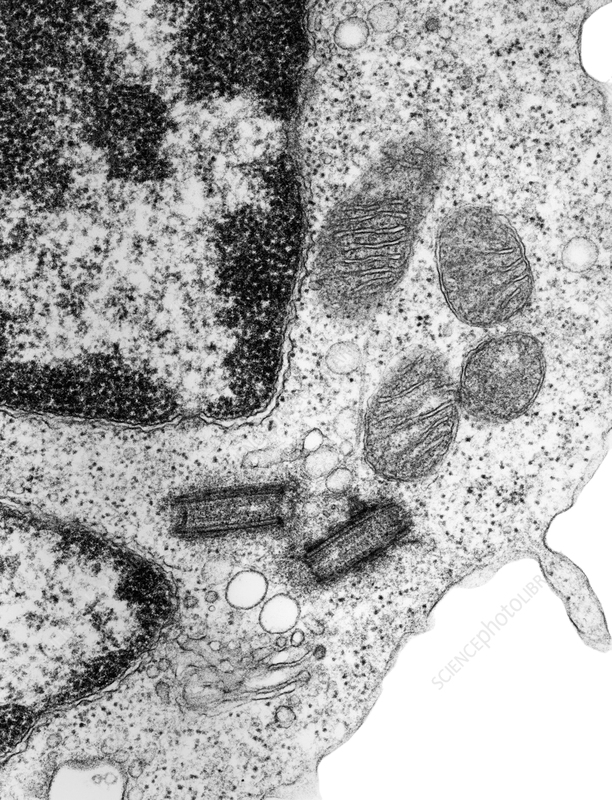
Chloroplast
Found in eukaryotic cells and produces sugar. This cell organelle also contributes to photosynthesis.
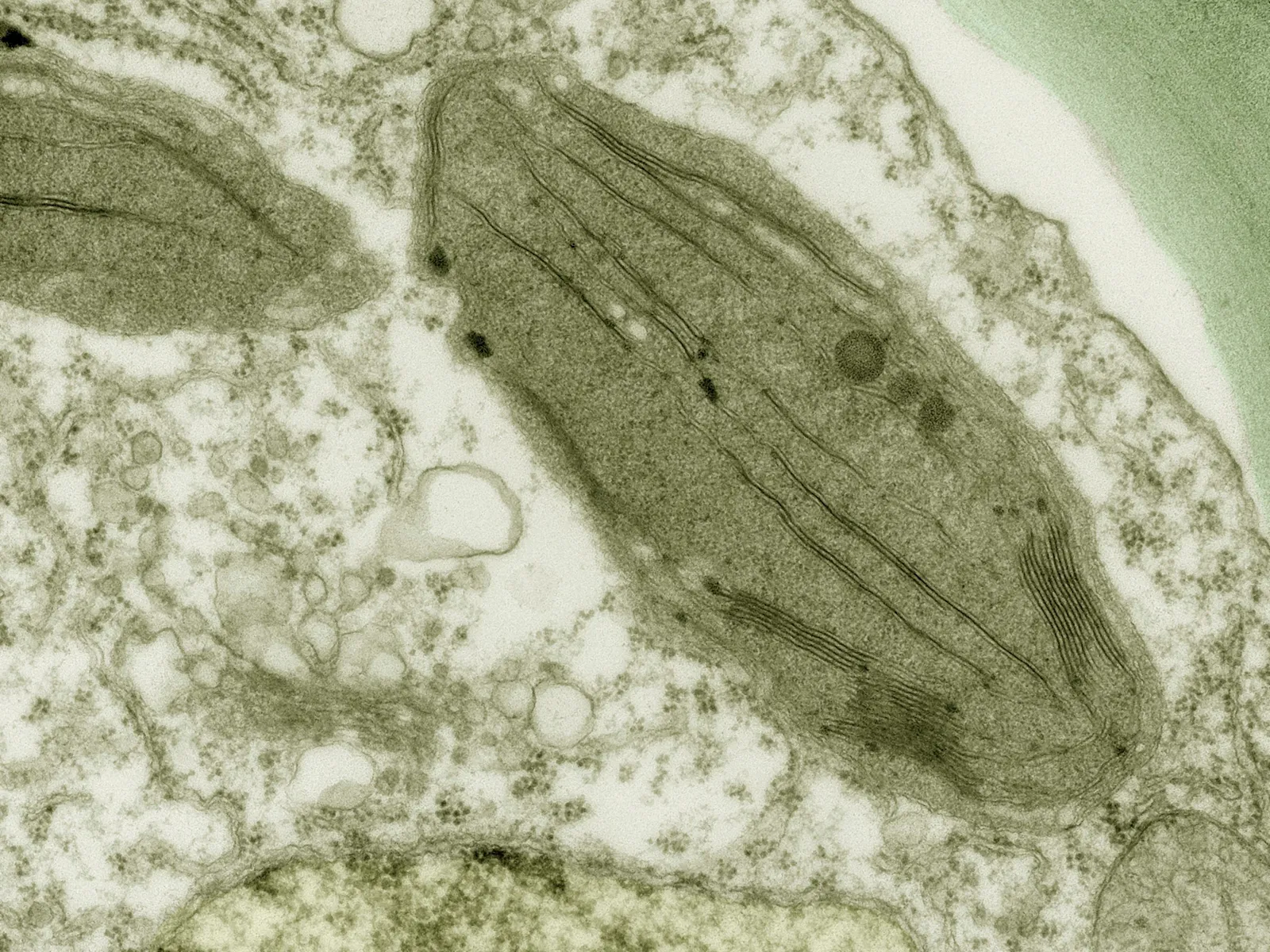
Cytoplasm
Found in both cells and has a jelly-like substance. Cytosol and cytoskeleton apart of cytoplasm supporting organelles.
(ER) Endoplasmic Reticulum
Found in eukaryotic cells and has many folds. Helps materials get around the cell and process molecules. There’s 2 of them a smooth and rough.
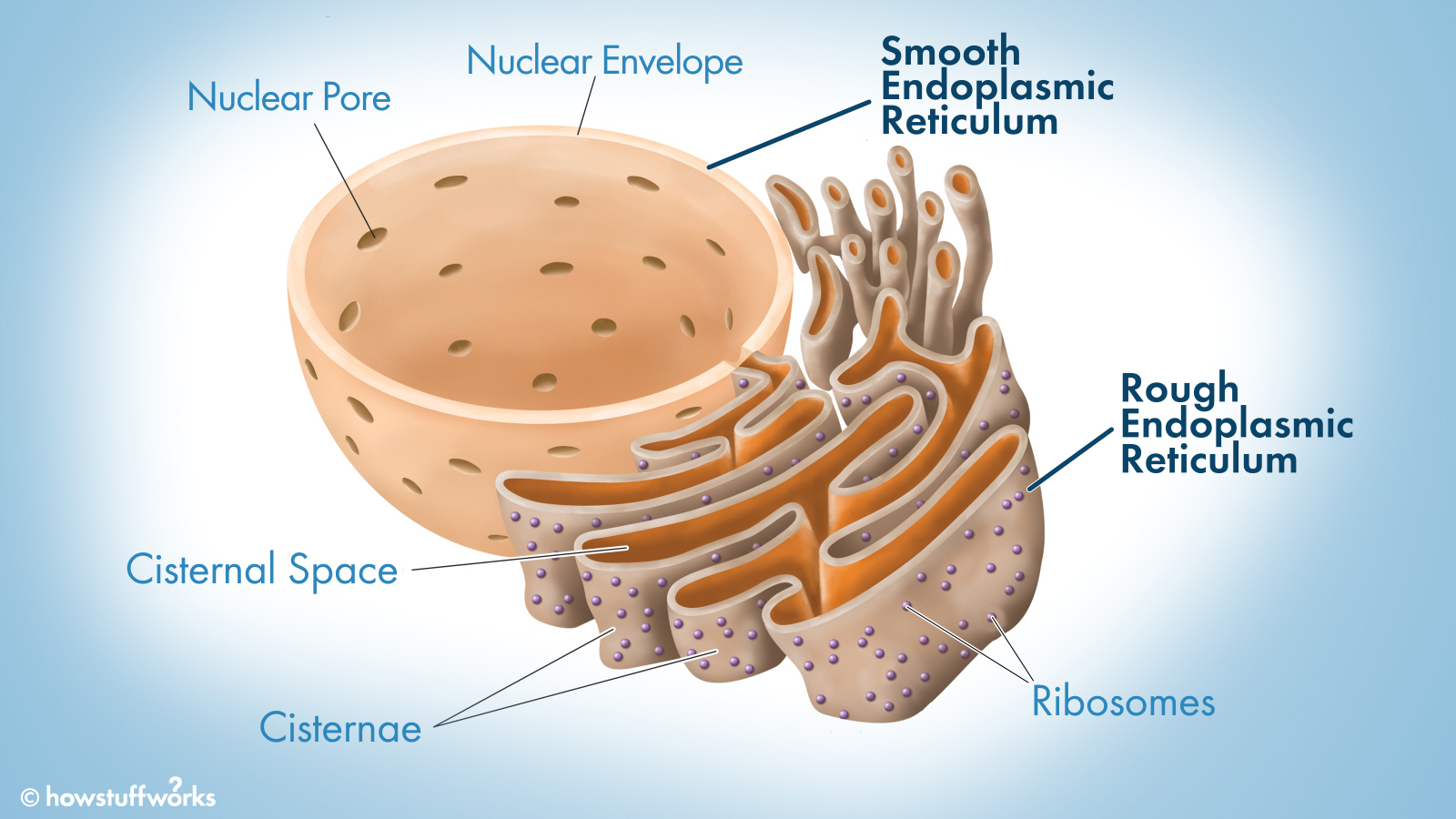
Golgi Apparatus
Assembles items sent from the ER and modifies, sorts, and packages materials for delivery. Found in eukaryotic cells.
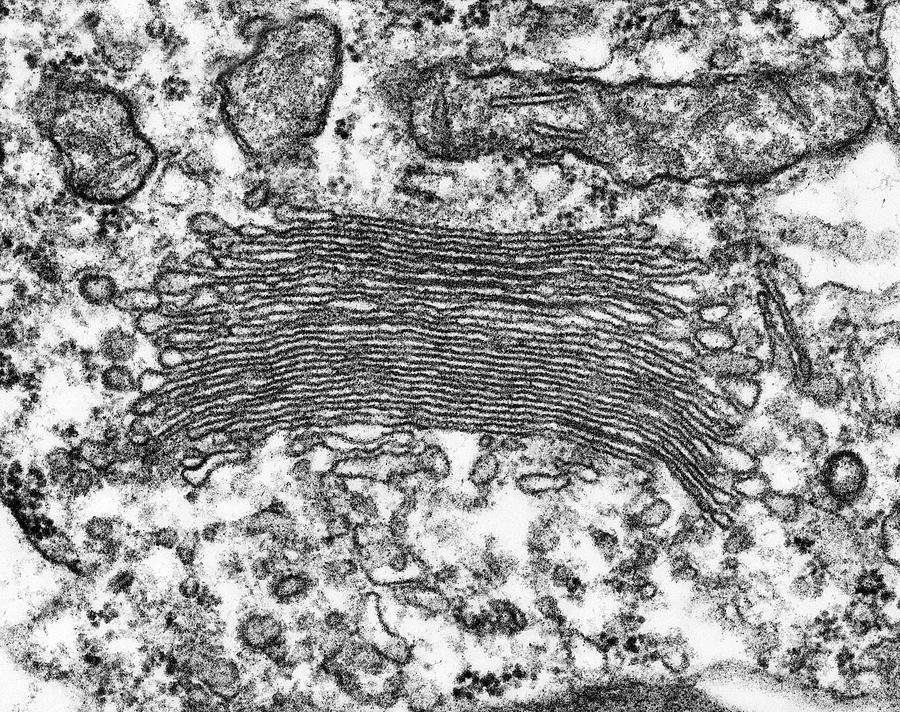
Lysosomes
Found in eukaryotic cells and has enzymes that can break down substances.
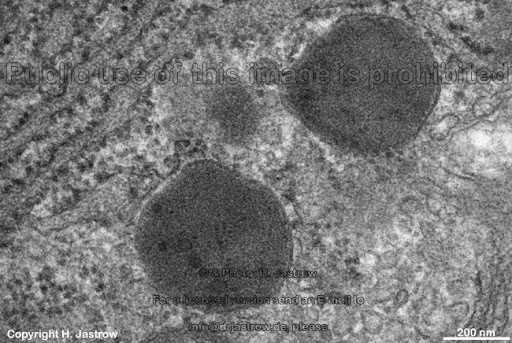
Mitochondria
This cell organelle is in eukaryotic cells and helps with cell respiration. This is because the organelle can make ATP which carries energy making it known as the powerhouse of the cell.
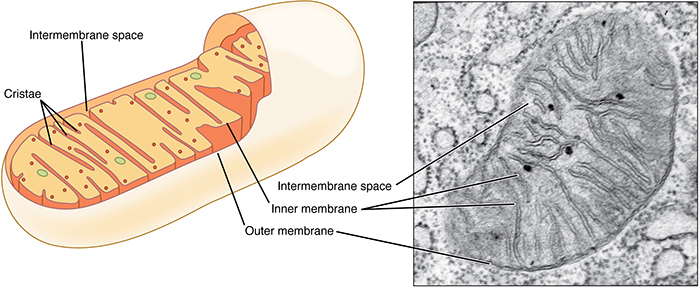
Nuclease
found in eukaryotic cells and houses the cell’s DNA. Which controls the cell’s activity.
Ribosome
Found in all cells and makes protein and is smaller then a lysosome.
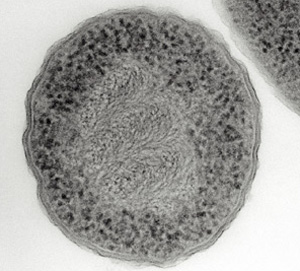
Vacuole
Found in eukaryotic cells and stores certain materials depending on the cell type. A animal cell has multiple tiny ones while a plant cell has one huge large one
IPMAT (Mitosis)
Known as the stages of mitosis, a type of cell division in eukaryotic cells. Mitosis is the process by which a single eukaryotic cell divides to produce two genetically identical daughter cells. The acronym IPMAT stands for the five main stages of mitosis:
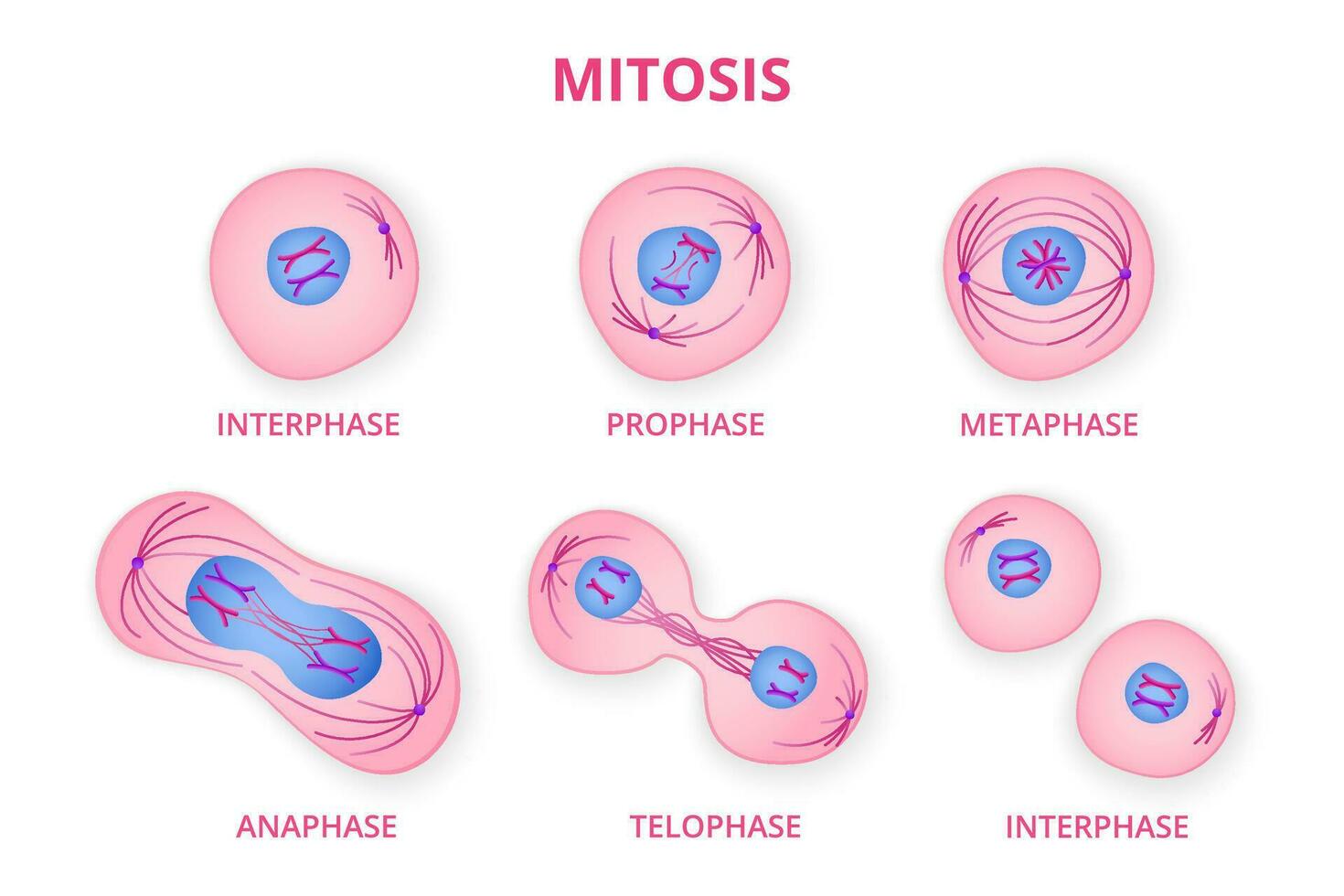
I - Interphase
This is the phase where the cell prepares for division. Technically, interphase is not part of mitosis, but it's essential because the cell grows and replicates its DNA in preparation for the next stages. Interphase consists of three sub-phases:
G1 (Gap 1): Cell growth and normal functions.
S (Synthesis): DNA replication.
G2 (Gap 2): Further growth and preparation for mitosis
P - Prophase
The chromatin (DNA) condenses into visible chromosomes. The nuclear membrane starts to break down, and the mitotic spindle, made of microtubules, begins to form. The centrioles (in animal cells) move to opposite sides of the cell.
M - Metaphase (middle)
The chromosomes align at the cell’s equatorial plane, known as the metaphase plate. The spindle fibers attach to the centromeres of the chromosomes.
A - Anaphase (away)
The sister chromatids (replicated chromosomes) are pulled apart towards opposite poles of the cell. This ensures each daughter cell will receive an identical set of chromosomes.
T - Telophase (2)
The chromatids reach the poles, and new nuclear membranes form around each set of chromosomes. The chromosomes begin to uncoil back into chromatin.
Cytokinesis
After telophase, cytokinesis occurs, where the cytoplasm divides, resulting in two separate daughter cells.
Digestive system
This system is responsible for breaking down food into nutrients that the body can absorb and use for energy, growth, and repair.

Mouth
Function: This is the entry point for food. Here, mechanical digestion starts as the teeth break down food into smaller pieces (chewing). The salivary glands produce saliva, which contains enzymes like amylase that start to break down carbohydrates into simpler sugars.
Process: After chewing, the food is mixed with saliva and formed into a soft mass called bolus. The tongue helps move the bolus to the back of the mouth for swallowing.
Esophagus
Function: This part is a muscular tube that connects the mouth to the stomach.
Process: When you swallow, the bolus moves down the esophagus through a series of wave-like muscle contractions called peristalsis. This pushes the food toward the stomach.
Stomach
Function: This is a large, muscular sac that further breaks down food. It produces gastric juices, which contain hydrochloric acid and enzymes like pepsin that help break down proteins. The stomach also churns food to mix it with digestive enzymes, turning it into a semi-liquid substance called chyme.
Process: Food enters the stomach through the lower esophageal sphincter, a muscle that prevents backflow. The stomach continues to churn and break down food chemically and mechanically.
Small Intestine
Function: The small intestine is a long, coiled tube where most of the digestion and absorption of nutrients occurs. It's divided into three parts: the duodenum, jejunum, and ileum.
Process:
Duodenum: This is the first part of the small intestine where bile (produced by the liver and stored in the gallbladder) and pancreatic juices (from the pancreas) mix with chyme. Bile helps digest fats, while pancreatic enzymes break down proteins, fats, and carbohydrates.
Jejunum: The middle section, where most nutrient absorption takes place. The walls of the jejunum are lined with tiny finger-like projections called villi, which increase surface area for absorption.
Ileum: The final part of the small intestine, where the remaining nutrients are absorbed into the bloodstream.
Liver
Function: The liver produces bile, which is stored in the gallbladder. Bile helps break down fats. The liver also processes nutrients absorbed by the small intestine and detoxifies harmful substances.
Process: After nutrients are absorbed into the bloodstream from the small intestine, the liver processes them to either store or release them into circulation as needed.
Gallbladder
Function: The gallbladder stores bile produced by the liver.
Process: When fat enters the duodenum, the gallbladder releases bile into the small intestine to help digest the fat.
Pancreas
Function: The pancreas produces pancreatic juices, which contain enzymes that help digest proteins, fats, and carbohydrates. It also produces insulin, which helps regulate blood sugar.
Process: The pancreas releases its digestive enzymes into the duodenum, aiding in the breakdown of food.
Large Intestine (Colon)
Function: The large intestine absorbs water and salts from the remaining undigested food, turning it into a solid form (feces). It also houses bacteria that help in the fermentation of some undigested materials.
Process: The material that enters the large intestine is mostly waste, and the colon absorbs any remaining nutrients and water. The waste then moves toward the rectum.
Rectum and Anus
Function: The rectum is the final part of the digestive system, where feces are stored before being expelled through the anus.
Process: Once the body has absorbed all the nutrients and water from food, the leftover waste material is excreted from the body through the anus in the form of feces.
Sum of Digestive System
Food enters the mouth where mechanical and chemical digestion begins.
It then travels down the esophagus and enters the stomach where further breakdown occurs.
In the small intestine, nutrients are absorbed, assisted by the pancreas, liver, and gallbladder.
The large intestine absorbs water, leaving solid waste.
Finally, waste is excreted from the body through the rectum and anus.
Respiratory System
The respiratory system is responsible for bringing oxygen into the body and removing carbon dioxide, a waste product of cellular metabolism.
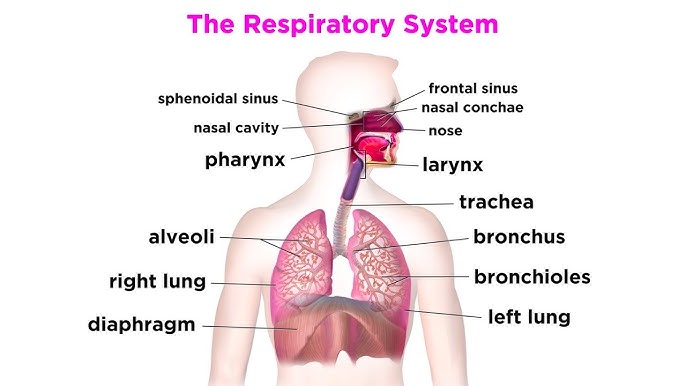
Nose and Nasal Cavity
Function: The nose is the primary entry point for air. It filters, humidifies, and warms or cools the air before it enters the lungs. The nasal cavity is lined with cilia (tiny hair-like structures) and mucus to trap dust, bacteria, and other particles.
Process: As air enters through the nostrils, it passes through the nasal cavity, where it’s cleaned and prepared for the lungs.
Pharynx (Throat)
Function: The pharynx is a muscular tube that connects the nose and mouth to the larynx (voice box). It serves as a pathway for both air and food.
Process: Air from the nasal cavity or mouth travels down the pharynx toward the larynx. The pharynx also helps prevent food from entering the airway when swallowing.
Larynx (Voice Box)
Function: The larynx houses the vocal cords, which vibrate to produce sound. It also acts as a passageway for air.
Process: As air moves through the larynx, the vocal cords can tighten or loosen to produce different sounds. The epiglottis, a flap of tissue, covers the trachea during swallowing to prevent food from entering the airway.
Trachea (Windpipe)
Function: The trachea is a rigid tube that connects the larynx to the bronchi. It is lined with cilia and mucus to trap particles and push them upward to be swallowed or expelled.
Process: Air travels down the trachea, which branches into the left and right bronchi, directing air into each lung.
Bronchi
Function: The bronchi are two tubes that branch off from the trachea, one leading into each lung. They continue to divide into smaller branches called bronchioles.
Process: Air travels through the bronchi into smaller bronchioles, which direct it to the alveoli (air sacs) where gas exchange occurs.
Lungs
Function: The lungs are the main organs of the respiratory system. They contain millions of tiny air sacs called alveoli, where the exchange of gases (oxygen and carbon dioxide) takes place.
Process: When air reaches the lungs, it moves through the bronchi and bronchioles until it reaches the alveoli. Oxygen from the air diffuses into the blood, and carbon dioxide from the blood diffuses into the alveoli to be exhaled.
Alveoli
Function: Alveoli are tiny, balloon-like sacs at the end of the bronchioles, where gas exchange occurs. They have very thin walls and are surrounded by a network of capillaries (tiny blood vessels).
Process: In the alveoli, oxygen passes from the air into the blood, where it binds to hemoglobin in red blood cells. At the same time, carbon dioxide in the blood passes into the alveoli to be exhaled.
Diaphragm
Function: The diaphragm is a large, dome-shaped muscle located beneath the lungs. It plays a key role in the process of breathing.
Process: When you inhale, the diaphragm contracts and moves downward, increasing the space in the chest cavity and allowing the lungs to expand. When you exhale, the diaphragm relaxes and moves upward, pushing air out of the lungs.
Breathing Process
Inhalation: When you inhale, the diaphragm contracts and moves downward, and the intercostal muscles (between the ribs) expand the chest. This increases the volume of the lungs, causing air to flow in through the nose or mouth, down the trachea, and into the lungs.
Exhalation: During exhalation, the diaphragm relaxes and moves upward, and the rib cage contracts. This reduces the volume of the lungs, forcing air (now rich in carbon dioxide) out of the body through the same pathway: lungs, bronchi, trachea, and out through the nose or mouth.
Sum of Respiratory System
Air enters through the nose or mouth, where it is filtered, warmed, and moistened.
It passes through the pharynx and larynx into the trachea and bronchi, eventually reaching the lungs.
Inside the lungs, air travels to the alveoli, where gas exchange occurs: oxygen enters the blood, and carbon dioxide is removed.
The diaphragm and other muscles help control the process of breathing, moving air in and out of the lungs.
Circulatory System
The circulatory system, also known as the cardiovascular system, is responsible for transporting blood, nutrients, gases (like oxygen and carbon dioxide), hormones, and waste products throughout the body.
Trading Carbon Dioxide in for Fresh Oxygen
The right ventricle pumps deoxygenated blood into the pulmonary trunk and out through the pulmonary artery.
Goes through pulmonary artery into lungs (gaining oxygen)
Oxygenated blood circles back to the heart and enters by way the pulmonary veins and right into a area of low pressure - left atrium.
The blood is push down into the left ventricle.

Sharing Oxygen Wealth
The blood then travels from the left ventricle into the aorta (allowing oxygen to be spread throughout the body since its a main artery)
After oxygen has been spread out to all cells for use, deoxygenated blood enters the heart from the superior and interior vena cava veins and into the right atrium.
The right atrium contracts the blood passes through a value into the right ventricle.
The cycle begins again (heart - lungs - heart - body)
Xylem
Definition: Xylem is a type of vascular tissue in plants responsible for transporting water and dissolved minerals from the roots to the rest of the plant.
Main Function: Water and mineral transport, providing structural support.
Phloem
Definition: Phloem is another type of vascular tissue that carries nutrients, especially sugars produced by photosynthesis, from the leaves to the rest of the plant.
Main Function: Transport of food (mainly sugars).
Mesophyll
Definition: Mesophyll is the tissue in plant leaves where most of the photosynthesis occurs. It is made up of two layers: the palisade mesophyll (which is tightly packed and contains most chloroplasts) and the spongy mesophyll (which is looser and allows for gas exchange).
Main Function: Photosynthesis, gas exchange.
Stomata
Definition: Stomata are small openings on the surface of plant leaves and stems that allow gases (like CO2 and O2) to be exchanged with the environment. They also help with water vapor loss (transpiration).
Main Function: Gas exchange and transpiration.
Guard Cells
Definition: Guard cells are specialized cells that surround each stoma and control its opening and closing, thus regulating the exchange of gases and water vapor.
Main Function: Regulating the opening and closing of stomata to control gas exchange and water loss.
Types of Tissue
Epithelial Tissue: Covers body surfaces and lines body cavities. It functions in protection, secretion, and absorption.
Connective Tissue: Supports and binds other tissues together. It includes bone, blood, adipose tissue, and cartilage. Its main function is structural support and nutrient transport.
Muscle Tissue: Responsible for movement. There are three types: skeletal, cardiac, and smooth.
Nervous Tissue: Conducts electrical impulses. It includes neurons and glial cells, and its main function is communication and control within the body.
Cancer
Definition: Cancer is a group of diseases characterized by uncontrolled cell growth and division. It occurs when cells begin to grow uncontrollably, forming abnormal cells that can invade surrounding tissues and spread to other parts of the body.
Main Feature: Uncontrolled cell growth and division.
Metastasis
Definition: Metastasis is the spread of cancer cells from the original (primary) tumor to distant parts of the body, forming secondary tumors. This occurs when cancer cells break away from the primary tumor and travel through the blood or lymphatic system to other organs.
Main Feature: Spread of cancer to other body parts.
Tumor
Definition: A tumor is a mass or lump of abnormal tissue caused by uncontrolled cell division. Tumors can be benign (non-cancerous) or malignant (cancerous). Malignant tumors can invade nearby tissues and metastasize.
Main Feature: Abnormal growth of tissue.
Mutation
Definition: A mutation is a change in the DNA sequence of a cell. Mutations can occur spontaneously or due to environmental factors like radiation, chemicals, or viruses. When mutations happen in genes that control cell growth and division, they can lead to cancer.
Main Feature: Changes in DNA that can lead to abnormal cell behavior.
Cancer Cell Division
Definition: Cancer cell division is the process by which cancer cells divide and proliferate uncontrollably. This occurs due to mutations in genes that regulate the cell cycle, such as oncogenes (which promote cell division) or tumor suppressor genes (which normally prevent uncontrolled division).
Main Feature: Unregulated and rapid cell division.
Cancer Treatment
Surgery: Removal of the tumor.
Chemotherapy: Use of drugs to kill or stop the growth of cancer cells.
Radiation Therapy: Use of high-energy radiation to kill cancer cells or shrink tumors.
Immunotherapy: Boosting or directing the body’s immune system to fight cancer.
Targeted Therapy: Drugs that specifically target cancer cells with fewer effects on normal cells.
Hormone Therapy: Used for cancers that rely on hormones to grow (e.g., breast cancer).
Main Feature: Aimed at eliminating cancer cells or controlling their growth.
Global Warming
Global warming refers to the long-term increase in Earth’s average surface temperature due to human activities, primarily the release of greenhouse gases (GHGs) like carbon dioxide (CO2), methane (CH4), and nitrous oxide (N2O). This warming contributes to climate change, affecting weather patterns, sea levels, ecosystems, and biodiversity.
Global Warming Occur From?
Burning of Fossil Fuels: When coal, oil, and natural gas are burned for energy, carbon dioxide and other pollutants are released into the atmosphere.
Deforestation: Trees absorb CO2, but when forests are cleared for agriculture or urban development, the carbon stored in those trees is released back into the atmosphere.
Agriculture: Agricultural practices, such as rice cultivation and livestock farming, release methane and nitrous oxide, two potent greenhouse gases.
Industrial Activities: Manufacturing processes, including cement production, release large amounts of CO2 and other greenhouse gases.
CO2
Potency: Moderate
Sources: Fossil fuel burning (coal, oil, natural gas), deforestation, cement production.
CH4
Potency: High (25x more potent than CO₂ over 100 years)
Sources: Livestock (e.g., cows), rice paddies, landfills, natural gas production.
N2O
Potency: High (298x more potent than CO₂)
Sources: Agriculture (fertilizers), industrial processes, fossil fuel combustion.
H2O (Vapor)
Potency: Varies (natural, but human activities influence)
Sources: Evaporation from oceans, lakes, and plants.
O3
Potency: Moderate (in the lower atmosphere)
Sources: Industrial activities, vehicle emissions, and chemical reactions in the atmosphere.
Negative Feedback Loop
Definition: A process that counteracts or reduces a change, helping to maintain stability or balance in a system.
Example: Body temperature regulation – When the body gets too hot, sweating and blood flow to the skin increase, cooling the body down. If the body gets too cold, shivering and reduced blood flow to the skin help warm it up.
Effect: Stabilizes the system by opposing changes.